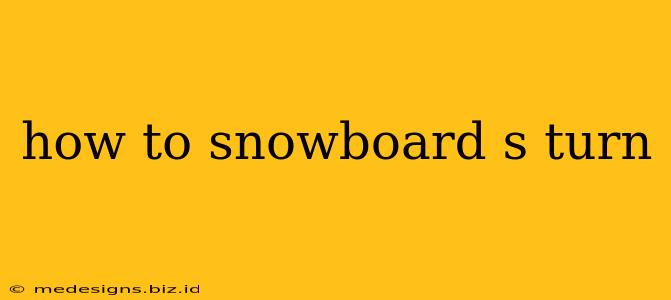Learning to snowboard is an exhilarating experience, but mastering the S turn is a crucial step in progressing from beginner to intermediate rider. This comprehensive guide will break down the technique, offering tips and tricks to help you confidently carve your way down the slopes.
Understanding the Fundamentals: Before You Start
Before you attempt S turns, ensure you have a solid grasp of the following:
- Comfortable riding: You should feel confident riding straight downhill, controlling your speed with your edges and maintaining balance.
- Basic turning: You should be able to execute basic heel and toe-side turns independently. This involves shifting your weight and applying pressure to the appropriate edge of your board.
- Edge control: Understanding how to engage and disengage your edges is essential for smooth transitions between turns.
- Body positioning: Maintaining a balanced and centered posture is crucial for stability and control.
Mastering the S Turn: A Step-by-Step Guide
The S turn involves linking together a series of heel-side and toe-side turns, creating a smooth, flowing S-shaped path down the slope. Here’s how to master it:
1. Starting Position:
Begin your descent on a gentle slope, maintaining a comfortable speed. Keep your knees bent, your weight centered, and your gaze directed downhill, focusing on your intended path.
2. Initiating the Heel-Side Turn:
- Shift your weight: Subtly shift your weight onto your heels, engaging your heel edge. Avoid leaning too far back; instead, focus on applying pressure through your heels.
- Steering with your body: Use your upper body to initiate the turn. Gently steer into the turn by leaning into it slightly.
- Control your speed: Regulate your speed with slight pressure adjustments on your heel edge.
3. Transitioning to the Toe-Side Turn:
- Prepare for the transition: As you approach the end of your heel-side turn, start to anticipate the transition to the toe-side. This requires a subtle shift in weight and body positioning.
- Shift your weight again: Gradually shift your weight towards your toes, engaging your toe edge.
- Execute the toe-side turn: Using a similar technique as the heel-side turn, steer the board into the toe-side turn using your upper body.
4. Linking Turns:
- Smooth transitions: The key to a fluid S turn is smooth transitions between heel-side and toe-side turns. Avoid jerky movements or abrupt changes in weight distribution.
- Consistent pressure: Maintain consistent pressure on the edges throughout each turn. This will help you maintain control and prevent skidding.
- Practice makes perfect: The more you practice, the smoother and more efficient your S turns will become.
Common Mistakes to Avoid
Many snowboarders struggle with S turns due to common mistakes. Here are a few to watch out for:
- Looking down at your board: Keep your gaze focused downhill to maintain balance and anticipate upcoming terrain.
- Leaning too far back or forward: Maintain a balanced, athletic stance with your weight centered.
- Jerky movements: Aim for smooth, flowing transitions between turns.
- Ignoring speed control: Regularly adjust your speed to maintain control.
Tips for Improvement
- Start on a gentle slope: Gradually increase the steepness of the slope as your confidence grows.
- Practice regularly: Consistent practice is key to mastering any snowboarding technique.
- Take lessons: Consider taking lessons from a qualified instructor for personalized feedback and guidance.
- Observe experienced riders: Watch how experienced snowboarders execute their turns. Pay attention to their body movements, weight distribution, and edge control.
Mastering the S turn is a rewarding accomplishment that will significantly improve your overall snowboarding experience. By following these tips and practicing consistently, you’ll be carving down the slopes with confidence in no time! Remember to prioritize safety and always wear appropriate safety gear. Happy riding!
